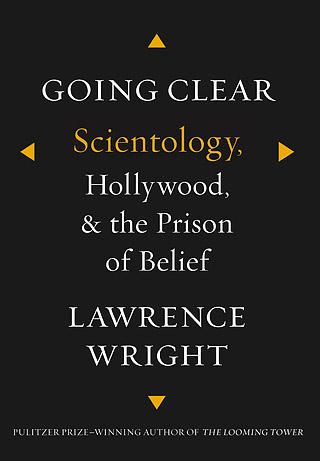 Now that we’ve read Going Clear: Scientology, Hollywood, & the Prison of Belief, we’re going to refrain from writing the sort of thing you’ve been seeing in some other publications. You know, the “Ten Most Explosive Things in Lawrence Wright’s New Book” sort of article.
Now that we’ve read Going Clear: Scientology, Hollywood, & the Prison of Belief, we’re going to refrain from writing the sort of thing you’ve been seeing in some other publications. You know, the “Ten Most Explosive Things in Lawrence Wright’s New Book” sort of article.
For those of us who watch Scientology closely, and have for many years, most of those articles that have popped up in recent days seem to be gasping over things that have been known or written about for many years.
Look, the history of Scientology is very weird. And scary. And the abuses detailed by former members can be shocking. And so can the tales of Scientology’s appetite for retaliation.
We know this. And we would argue that for much of the public, the word was already out long before today’s publication of Wright’s book. (Look at the reaction, for example, when on Monday the Atlantic magazine ran a paid church advertorial at its website extolling the virtues of Scientology leader David Miscavige. Even though there was nothing really wrong with the Atlantic taking the church’s money for an ad, the public denunciation of the magazine was so swift and loud, the Atlantic caved and took it down.)
Larry Wright’s book carefully explains how the church got into its current mess, and the sheer amount of territory he covers in only 365 pages is astounding. Yes, there are stunning new details in every chapter, but Wright weaves together his story with such hypnotic flow and even-handedness, the new and the old fit together seamlessly.
Wright seems very conscious of that project. He’s generous to his sources, he doesn’t try to pretend that he’s coming to a story that hasn’t been worked over before, and he’s as fair as he can be to the church (although it would never acknowledge it).
For now, we’re going to lay down a few impressions after our first read through the book, and we will rely on our excellent and knowledgeable commenting community to help us highlight what are some of the surprises in its pages, from Spanky Taylor’s memories as John Travolta’s church handler, for example, to Stephen “Sarge” Pfauth’s account of helping Hubbard, at the end of his life, construct a sort of electrical “suicide machine.” If you spot something in Wright’s book that you haven’t read before, please point it out in the comments.
As in his previous New Yorker article, Wright uses screenwriter and film director Paul Haggis to anchor his narrative. Haggis is a great subject because he is such an intelligent and sensitive soul, and we naturally wonder, how does someone like that fall for the Scientology promise of immortality through Hubbard’s “technology”?
Wright explains what it was in Haggis’s background that helped make him ready to find Scientology attractive, and then Wright provides a fascinating description of Hubbard’s invention.
To some extent, Wright says, Scientology was a mapping of Hubbard’s own psyche.
“Scientology is the geography of his mind. Perhaps no individual in history has taken such copious internal soundings and described with so much logic and minute detail the inner workings of his own mentality,” he writes.
Ex-Scientologists have said something like that to us before, that they felt they had been “running Hubbard’s case” throughout their careers in the church. (In other words, that it wasn’t so much their own mental hangups they’d been forced to work on, but Hubbard’s.)
And Hubbard’s mental journey was a doozy. There have been excellent biographies of the man published in the past. Russell Miller’s Bare-Faced Messiah (1987) is still the most comprehensive for the Hubbard family’s overall development, and Jon Atack’s A Piece of Blue Sky (1990) is still a stunning achievement for considering both Hubbard and Scientology. Janet Reitman in 2011 brought to a much larger market her well-written history, Inside Scientology, but we remember thinking that she seemed to hold back in some ways which were curious. For example, it struck us that she was leaving out some of the most interesting details about Hubbard’s post-war association with rocket scientist and occultist Jack Parsons.
Wright dives into that material with gusto, and we’re not soon going to forget some of the images he describes. Of Parsons jerking off onto parchment as Hubbard takes notes, for example, which was apparently part of their nutty attempts to bring about a new age. Or something.
Wright also makes liberal use of a disturbing unpublished sort of memoir that Hubbard penned which he called “Affirmations.” It’s a disputed document, but Ohio State University professor Hugh Urban has pointed out that the church fought hard in Gerry Armstrong’s lawsuit to keep control of it, and why would they do that for a document that wasn’t genuine?
Wright also tracks down startling letters by or about Hubbard. In one he wrote to his good friend Robert Heinlein, in the period before he published Dianetics and was on the mend after his disastrous post-war period, he claims that his recovered sexual prowess has him up to “eight comes” a night. Between the letters and “Affirmations,” Hubbard’s legendary “charm” takes a serious beating in this book.
A question for our experts: Wright quotes from tapes that Hubbard’s second wife, Sara Northrup, made on her deathbed, which are in the possession of University of Alberta professor Stephen Kent. Have those been made public before Wright’s book? I can’t recall, but they provide more devastating information about Hubbard.
Much other information is not new, but Wright makes use of it in new ways. We might know about the Tone Scale, for example, Hubbard’s theory about mapping human emotions on a gradient. And we might also be aware of the disastrous way that Hubbard’s second marriage, to Northrup, turned out. But one of the strengths of Wright’s book is the way he puts these seemingly disparate elements in Scientology’s story into their proper context. Reading the Tone Scale knowing that when Hubbard wrote it he was in Cuba, having absconded with Alexis, the young daughter Hubbard had with Northrup, suddenly makes it more sinister and more understandable at the same time.
With all of this information, new and old, Wright, more strongly than anyone before him, assembles a damning portrayal of Hubbard as a man who was, most likely, simply insane.
We’ve noticed, however, that several reviewers have offered mild criticism about the amount of detail and the scope of the book. Oh, they have no idea. Wright actually moves through the historical material at a rapid pace. If you’re familiar with Miller and Atack and other books, you know just how much more there is to every period that Wright is describing. But he’s chosen the best material and he tells it in a fast-moving style.
The story of Scientology is not just the story of Hubbard, of course, and current leader David Miscavige comes into focus better than in anything published about him previously. Wright digs deep into the diminutive man’s early years in the church, and we learn that his predilection for violence started very early. Wright reports that as just a teenager in England, Miscavige had gotten in trouble for punching a young woman he was supposed to be counseling. “He beat up his PC!” may soon become a new Anonymous meme.
Joe Childs and Tom Tobin deserved a Pulitzer in 2009 when, for the St. Petersburg Times, they first brought to the world the story of high-ranking former executives who came forward to describe Miscavige’s physical assaults on his underlings (which the church vigorously denies). But Wright extends that history, showing that Miscavige was known for slugging people over many years.
But even with the bizarre nature of David Miscavige, the accounts of confinement and mental abuse of its former workers, and Scientology’s use of “Fair Game” retalitation against people it considers enemies which are all so well told in this book, Wright still seems to be running into, even in reviews which are generally positive, some resistance from the likes of the Wall Street Journal and the New York Times. To wit: why does this stuff matter?
Even Wright himself acknowledges that Scientology’s more outlandish beliefs — about the galactic overlord Xenu, for example — may be no crazier than tales of walking on water or visitions by angels. And the “prisoners” at Int Base, serving time in Scientology’s concentration camp, “the Hole”? They probably wouldn’t tell you they need rescuing. And the ex-Scientologists who were helping the FBI with its investigation in 2009 and 2010 told them raiding the base was probably a bad idea.
The IRS, meanwhile, seems to have no interest in revisiting its 1993 decision to grant Scientology tax-exempt status.
But Scientology is collapsing without government help, and it’s fascinating to watch. And maybe that’s the simple answer to the critics who shrug and wonder what the fuss is all about. For some of us, it’s stunning to see the way Scientology has used the First Amendment in such cynical ways, and has been able to frighten even the most powerful media companies into submission (ABC, we’re looking at you). And we’re not alone. There’s huge interest in Scientology, and that, maybe more than anything else, justifies its importance as a subject. Wright’s New Yorker story on Haggis, for example, wasn’t just the second-most read story on the magazine’s website for 2011 (behind only its detailed story on the killing of Osama Bin Laden), but it was also one of its most read stories for 2012. We are eagerly waiting to see how well Going Clear sells.
We have a feeling that its sales will be straight up and vertical.
Here’s Larry’s appearance this morning on the Today show…
Visit NBCNews.com for breaking news, world news, and news about the economy
Hey look! ABC dared to use about 20 seconds of the hours of footage they shot last summer! Maybe there’s some hope for the Disney network yet!






